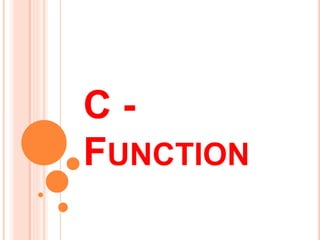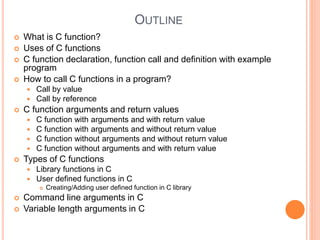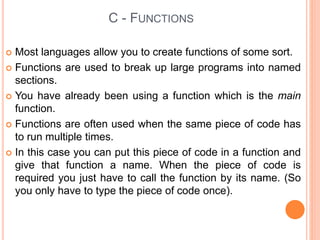C functions
- 1. C - FUNCTION
- 2. OUTLINE What is C function? Uses of C functions C function declaration, function call and definition with example program How to call C functions in a program? Call by value Call by reference C function arguments and return values C function with arguments and with return value C function with arguments and without return value C function without arguments and without return value C function without arguments and with return value Types of C functions Library functions in C User defined functions in C Creating/Adding user defined function in C library Command line arguments in C Variable length arguments in C
- 3. WHAT IS C FUNCTION? A function is a group of statements that together perform a task. Every C program has at least one function, which is main(). You can divide up your code into separate functions. How you divide up your code among different functions is up to you, but logically the division usually is so each function performs a specific task. A function declaration tells the compiler about a function's name, return type, and parameters. A function definition provides the actual body of the function. The C standard library provides numerous built-in functions that your program can call. For example, function printf() to print output in the console. A function is known with various names like a method or a sub- routine or a procedure, etc.
- 4. Most languages allow you to create functions of some sort. Functions are used to break up large programs into named sections. You have already been using a function which is the main function. Functions are often used when the same piece of code has to run multiple times. In this case you can put this piece of code in a function and give that function a name. When the piece of code is required you just have to call the function by its name. (So you only have to type the piece of code once). C - FUNCTIONS
- 5. C - FUNCTIONS In the example below we declare a function with the name MyPrint. The only thing that this function does is to print the sentence: “Printing from a function”. If we want to use the function we just have to call MyPrint() and the printf statement will be executed.
- 6. DEFINING A FUNCTION The general form of a function definition is as follows: A function definition in C language consists of a function header and a function body.
- 7. Here are all the parts of a function: Function Name: This is the actual name of the function. The function name and the parameter list together constitute the function signature. Parameters: A parameter is like a placeholder. When a function is invoked, you pass a value to the parameter. This value is referred to as actual parameter or argument. The parameter list refers to the type, order, and number of the parameters of a function. Parameters are optional; that is, a function may contain no parameters. Return Type: A function may return a value. The return type is the data type of the value the function returns. If you don’t want to return a result from a function, you can use void return type. Some functions perform the desired operations without returning a value. In this case, the return type is the keyword void. Function Body: The function body contains a collection of statements that define what the function does. PARTS OF A FUNCTION
- 8. EXAMPLE: FUNCTION Following is the source code for a function called max(). This function takes two parameters num1 and num2 and returns the maximum between the two:
- 9. FUNCTION DECLARATIONS A function declaration(function prototype) tells the compiler about a function name and how to call the function. The actual body of the function can be defined separately. A function declaration has the following parts: For the above defined function max(), following is the function declaration: Parameter names are not important in function declaration only their type is required, so following is also valid declaration: Function declaration is required when you define a function in one source file and you call that function in another file. In such case you should declare the function at the top of the file calling the function.
- 10. CALLING A FUNCTION While creating a C function, you give a definition of what the function has to do. To use a function, you will have to call that function to perform the defined task. When a program calls a function, program control is transferred to the called function. A called function performs defined task and when its return statement is executed or when its function-ending closing brace is reached, it returns program control back to the main program. To call a function, you simply need to pass the required parameters along with function name, and if function returns a value, then you can store returned value. For example:
- 12. CODE EXAMPLE: CALLING A FUNCTION
- 13. CODE EXAMPLE: CALLING A FUNCTION A C program with function declaration/fu nction prototype.
- 14. FUNCTION ARGUMENTS C functions can accept an unlimited number of parameters. If a function is to use arguments, it must declare variables that accept the values of the arguments. These variables are called the formal parameters of the function. The formal parameters behave like other local variables inside the function and are created upon entry into the function and destroyed upon exit.
- 15. GLOBAL AND LOCAL VARIABLES Local variable: A local variable is a variable that is declared inside a function. A local variable can only be used in the function where it is declared. Global variable: A global variable is a variable that is declared outside all functions. A global variable can be used in all functions. See the following example( see the next slide )
- 16. As you can see two global variables are declared, A and B. These variables can be used in main() and Add(). The local variable answer can only be used in main(). GLOBAL AND LOCAL VARIABLES
- 17. TYPE OF FUNCTION CALL Call Type Description Call by value This method copies the actual value of an argument into the formal parameter of the function. In this case, changes made to the parameter inside the function have no effect on the argument. Call by reference This method copies the address of an argument into the formal parameter. Inside the function, the address is used to access the actual argument used in the call. This means that changes made to the parameter affect the argument. While calling a function, there are two ways that arguments can be passed to a function:
- 18. CALL BY VALUE The call by value method of passing arguments to a function copies the actual value of an argument into the formal parameter of the function. In this case, changes made to the parameter inside the function have no effect on the argument. By default, C programming language uses call by value method to pass arguments. In general, this means that code within a function cannot alter the arguments used to call the function. Consider the function swap() definition as follows.
- 19. CALL BY VALUE Consider the function swap() definition as follows.
- 20. CALL BY VALUE Now, let us call the function swap() by passing actual values as in the following example: Output: The output shows that there is no change in the values though they had been changed inside the function.
- 21. CALL BY REFERENCE The call by reference method of passing arguments to a function copies the address of an argument into the formal parameter. Inside the function, the address is used to access the actual argument used in the call. This means that changes made to the parameter affect the passed argument. To pass the value by call by reference, argument pointers are passed to the functions.
- 22. FUNCTION CALL BY REFERENCE To pass the value by reference, argument pointers are passed to the functions just like any other value. So accordingly you need to declare the function parameters as pointer types as in the following function swap(), which exchanges the values of the two integer variables pointed to by its arguments.
- 23. CALL BY REFERENCE Let us call the function swap() by passing values by reference as in the following example: Which shows that the change has reflected outside of the function as well unlike call by value where changes does not reflect outside of the function. Output:
- 24. RECURSION Recursion is the process of repeating items in a self-similar way. Same applies in programming languages as well where if a programming allows you to call a function inside the same function that is called recursive call of the function as follows. The C programming language supports recursion, i.e., a function to call itself. But while using recursion, programmers need to be careful to define an exit condition (base condition) from the function, otherwise it will go in infinite loop. Recursive function are very useful to solve many mathematical problems like to calculate factorial of a number, generating Fibonacci series, etc.
- 25. NUMBER FACTORIAL Following is an example, which calculates factorial for a given number using a recursive function:
- 28. FIBONACCI SERIES Following is another example, which generates Fibonacci series for a given number using a recursive function:
- 29. Function Example: 1. Implement the following Temperature conversion functions: i) function Celsius returns the Celsius equivalent of a Fahrenheit temperature, using the calculation: celsius = 5.0 / 9.0 * ( fahrenheit - 32 ); ii) function Fahrenheit returns the Fahrenheit equivalent of a Celsius temperature, using the calculation: fahrenheit = 9.0 / 5.0 * (celsius + 32); Use the functions from parts (i) and (ii) to write an application that enables the user to choose either to enter a Fahrenheit temperature and display the Celsius equivalent or to enter a Celsius temperature and display the Fahrenheit equivalent.
- 30. #include<stdio.h> #include<conio.h> float Celsius(float F) { float c; c=((F-32)*5)/9; return c; } float Fahrenheit(float C) { float f; f=((9*C)/5)+32; return f; } int main() { char ch; float cels, farn; printf("nnWhich conversion you prefer?nnn"); printf(" 1.For Celsius to Fahrenheitn 2.For Fahrenheit to Celsius"); ch=getch(); switch(ch) { case '1': printf("nnEnter temperature in Celsius: "); scanf("%f",&cels); farn=Fahrenheit(cels); printf("nnConverted temperature in Fahrenheit: %f",farn); break; case '2': printf("nnEnter temperature in Fahrenheit: "); scanf("%f",&farn); cels=Celsius(farn); printf("nnConverted temperature in Celsius: %f",cels); break; default: printf("nnWrong Choice....Have a good day!!"); break; } return 0; }
- 31. 2. Write codes for two functions named ArraySum and ArrayAvg with appropriate parameter and return type to find out the sum and average from an integer array. Call these functions from the main function, pass the integer array and print the returned sum and average in the main function. Hint: If you pass an array which has 3, 1, 4, 2, 5 as its elements than ArraySum will return 15 and ArrayAvg will return 3.
- 32. #include<stdio.h> #include<conio.h> #include<malloc.h> int ArraySum(int *a,int Size) { int i,sum=0; for(i=0;i<Size;i++) { sum=sum+*(a+i); } return sum; } float ArrayAvg(int *a,int Size) { int i; float avg,sum=0; for(i=0;i<Size;i++) { sum=sum+*(a+i); } avg = sum/Size; return avg; } int main() { int N,sum,i,*Ary; float avg; printf("nnnHow many elements in your array??? "); scanf("%d",&N); Ary=(int*)malloc(sizeof(int)*N); //Dynamic Memory Allocation printf("nnEnter %d Elements of your Arrayn",N); for(i=0;i<N;i++) { scanf("%d",&Ary[i]); } sum=ArraySum(Ary,N); printf("nnSum of Array Elements: %d",sum); avg=ArrayAvg(Ary,N); printf("nnAverage of Array Elements: %.3f",avg); free(Ary); getch(); return 0; }
































![#include<stdio.h>
#include<conio.h>
#include<malloc.h>
int ArraySum(int *a,int Size)
{
int i,sum=0;
for(i=0;i<Size;i++)
{
sum=sum+*(a+i);
}
return sum;
}
float ArrayAvg(int *a,int Size)
{
int i;
float avg,sum=0;
for(i=0;i<Size;i++)
{
sum=sum+*(a+i);
}
avg = sum/Size;
return avg;
}
int main()
{
int N,sum,i,*Ary;
float avg;
printf("nnnHow many elements in your array??? ");
scanf("%d",&N);
Ary=(int*)malloc(sizeof(int)*N); //Dynamic Memory Allocation
printf("nnEnter %d Elements of your Arrayn",N);
for(i=0;i<N;i++)
{
scanf("%d",&Ary[i]);
}
sum=ArraySum(Ary,N);
printf("nnSum of Array Elements: %d",sum);
avg=ArrayAvg(Ary,N);
printf("nnAverage of Array Elements: %.3f",avg);
free(Ary);
getch();
return 0;
}](https://image.slidesharecdn.com/cfunctions-161130212937/85/C-functions-32-320.jpg)